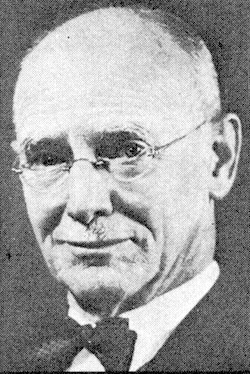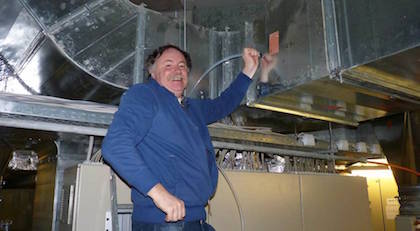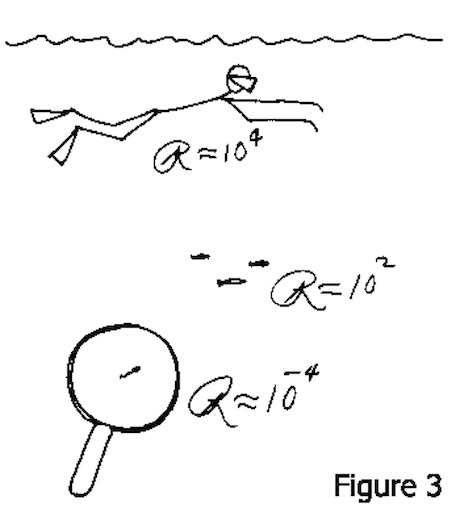Marc Abrahams's Blog, page 258
August 2, 2016
This book is worth study but it’s annoying to read
 This book is worth study but it’s annoying to read, is the general message of this item in a medical journal:
This book is worth study but it’s annoying to read, is the general message of this item in a medical journal:
“This book is worth study but it’s annoying to read,” T.L. Fisher, Canadian Medical Association Journal, vol. 111, no. 11, December 7, 1974, p. 1279.
T.L. Fisher is pictured here.
The book in question is:
The Physician and Canadian Law, by T. David Marshall, LL.B., M.D.

August 1, 2016
The president’s take on the Ig Nobel session at ESOF
The following is reprinted from the The University of Manchester:

Professor Dame Nancy Rothwell
The University of Manchester
President’s Weekly Update
28 July 2016
This week has been dominated by ESOF 2016 (EuroScience Open Forum) of which I was the President and ‘Champion’, along with Professor Luke Georghiou, Vice-President for Research and Innovation, who was co-Champion.
The conference hosted about 3,000 attendees from 83 countries with 700 speakers, over 150 sessions and over 400 science journalists and communicators. It was based mainly at Manchester Central, with many events taking place at the University. Some delegates also visited the National Graphene Institute, Jodrell Bank Observatory and the headquarters of the Square Kilometre Array (SKA) at Jodrell….
I attended many fantastic presentations – sometimes trying to be in several places at once – and met many friends from science, business and the press. Certainly the funniest session was about the Ig Nobel prize – a parody of the Nobel Prizes given each year for ten unusual achievements in scientific research and which aim to: “honour achievements that first make people laugh, and then make them think.” This session included contributions from Professor Sir Andre Geim who has received both an Ig Nobel Prize and Nobel Prize….
— Nancy Rothwell, President and Vice-Chancellor

The purpose of the prominent human external nose (a theory)
Many might have wondered, at one time or another, about the purpose of the prominent human external nose. Of those people, Howard D. Stupak, M.D., who is Assistant Professor, Department of Otorhinolaryngology, Head & Neck Surgery and Chair, Department of Otolaryngology at Jacobi Medical Center, Albert Einstein College of Medicine, Bronx, New York, has a theory. His theory is that the nose may have evolved over millions of years, becoming larger due to its evolutionary advantages as a snore-mitgating device.
“The purpose of the prominent human external nose remains unclear.”
– he says, nonetheless going on to outline his hypothesis :
“The external nose may play a compensatory role in the aerodynamic support of the upper airway, which in humans has been severely narrowed to enable spoken language. During times of decreased muscle tone, the wing-like soft palate may be supported by airflow patterns, creating ‘lift.’ Serving as an aiming nozzle, the external nose may, by creating a curvilinear intranasal airflow pattern, adjust the ‘angle of attack’ of airflow contacting the palate, thus enhancing lift and facilitating opening of the nasopharynx.”
See: ‘The human external nose and its evolutionary role in the prevention of obstructive sleep apnea’ in: Otolaryngol Head Neck Surg June 2010 vol. 142 no. 6 779-782.
Question [optional]: Do people with abnormally large noses tend to snore more, less, or the same amount as those with ‘normal’ sized noses?
Further reading: Improbable features an expanding database of nose-related information – start your enquiries here.

July 31, 2016
Where the statistical wear is
Ivars Peterson, in his blog, The Mathematical Tourist, explains how a detective take a mathematical approach to some everyday questions:
Marks on objects can provide intriguing statistical glimpses of usage patterns. The darkened leaves of a well-thumbed book may point to favorite passages; the distinctive hollows of oft-traversed steps suggest the characteristic tread of countless feet….
I happened to notice a particularly striking example of such “statistical wear” on the door to the men’s restroom, just down the hall from my office. Entry to the restroom was by a swinging door, which opened inward with a push. Countless hands pushing on the door had worn away the brown stain in one particular area, reflecting where men had preferred to place a hand. The result was a roughly circular spot—a two-dimensional statistical distribution—with the most wear in the middle and progressively less wear away from the center….
What pattern would you expect to see on a nearly identical swinging door to the women’s restroom? The pattern is similar, but it is lower and a little closer to the door’s edge, reflecting a lower average height and a greater preference for pushing with less force. As a result, the pattern has a significantly greater overlap with the door’s brass plate.


July 30, 2016
Algorithm Predicts Hillary Clinton will defeat Donald Trump to become the 45th President of the United States
by Eric Schulman and Daniel Debowy
July 28, 2016
Now that both major U.S. political parties have announced their nominees for president and vice president and the nominees have accepted these nominations, the Annals of Improbable Research U.S. Presidential Election Algorithm (Debowy and Schulman 2003) can be used to predict the results of the upcoming November election.

photo of D. Trump: Todd Heisler/The New York Times
photo of H. Clinton: Daniel Acker/Bloomberg via Getty Images
The algorithm predicts that the Democratic ticket of Hillary D. R. Clinton and Timothy M. Kaine will defeat the Republican ticket of Donald J. Trump and Michael R. Pence on November 8, 2016.
The algorithm was developed based on the experience of the major party candidates for president and vice president in each of the 54 U.S. presidential elections between 1789 and 2000 and it correctly predicted the outcome of the 2004, 2008, and 2012 U.S. presidential elections.
Background: About the election-prediction algorithm
According to the algorithm, being a United States senator does not contribute to one’s electability for president or vice president but being governor contributes one vice presidential electability point per year served, so the Clinton/Kaine ticket has a total electability of 4 because Timothy M. Kaine was governor of Virginia for four years. A presidential candidate loses 110 electability points if they have been divorced and a vice presidential candidate receives one electability point per year served in the U.S. House of Representatives, so the Trump/Pence ticket has a total electability of -94 because Donald J. Trump has been divorced (twice, but the electability penalty is only applied once) and Michael R. Pence was a member of the U.S. House of Representatives for 12 years and has been governor of Indiana for three years and part of a fourth. Although being the president or chancellor of a college or university would add 110 electability points, being the owner of an unaccredited for-profit real estate training company adds nothing, even if that company has “University” in its name.
The Annals of Improbable Research U.S. Presidential Election Algorithm has a 100% rate of successful predictions but the majority of major party primary voters do not appear to have accepted the validity of this algorithm. Schulman and Debowy (2015) found two Democratic candidates with a higher presidential electability than Hillary D. R. Clinton’s electability of 0 (Martin J. O’Malley with 88 and Lincoln D. Chafee with 154) and 14 Republican candidates with a higher presidential electability than Donald J. Trump’s -110 (James S. Gilmore III with -66; John R. Kasich with -26; Rafael E. Cruz, Randal H. Paul, and Marco A. Rubio with 0; Richard J. Santorum with 4; Lindsey O. Graham with 8; Michael D. Huckabee with 11; Scott K. Walker with 66; Christopher J. Christie with 77; John E. Bush with 88; Piyush Jindal with 91; George E. Pataki with 132; and James R. Perry with 165).

Mousetube
MouseTube is, in the words of its founders, a web application that “allows the exchange of mouse vocalisation recording files“.
There are, of course, other, unrelated kinds of mouse tubes that involve song:

July 29, 2016
High quality literature production and mating success
“
We hypothesized that the quantitative and qualitative literary output of famous writers would correlate with their number of mates, children, and grandchildren.
We further assumed that writing lyric poetry would be more beneficial for mating success than nonpoetry because the former consists of more verbal handicaps (e.g., rhymes) than the latter and thus requires special literary competences.”
– so write Dr Benjamin P. Lange [pictured left] (University of Kassel and University of Göttingen) and Prof. Harald A. Euler [pictured right] (University of Kassel) in: Evolutionary Behavioral Sciences, Vol 8(1), Jan 2014, 20-30. See: ‘Writers have groupies, too: High quality literature production and mating success’.
“In support of the hypothesis that high-quality literature production is associated with mating success, we found, for both canons [i.e. Germany and US], several correlations between markers of literary success and quality, on the one hand, and mating and reproductive successes, on the other hand. As expected, this was less the case for marriages, whereas the highest correlations were found for number of affairs, girlfriends, and romances, because affairs are mating successes that best serve a male quantitative reproductive strategy.”
They also note, with regard to poets:
“The observations that poets die younger, produce their works earlier, have—at least by trend—more mates than nonpoets, and that poetry constitutes a larger verbal handicap than prose could lead to the hypothesis that poets are relatively more quantitative strategists and, furthermore, have higher levels of testosterone than nonpoets. Testosterone could be one major proximate mechanism behind the (male) motivation for literary displays.”
The paper may be read in full here.

July 28, 2016
No plague in the NY subway after all (new study)
Travellers on the New York and Boston subway systems might allow themselves a sigh of relief – Yersinia pestis (the causative agent of plague) and Bacillus anthracis (the causative agent of anthrax) might not be living in the subway systems after all. This is the finding of a new investigation published in the journal mSystems™, May/June 2016; volume 1, issue 3. The paper refutes the findings of a previous study (‘Geospatial Resolution of Human and Bacterial Diversity with City-Scale Metagenomics’ in: CellSystems, Volume 1, Issue 1, p72–87, 29 July 2015.) Here’s a commentary :
“[…] in a recent study of the New York subway, due to incorrect taxonomic classifications, the authors reported observing Yersinia pestis (the causative agent of plague) and Bacillus anthracis (the causative agent of anthrax) as part of the ‘normal subway microbiome.’ These observations led to high-visibility news reports. But improved reanalysis of the same data by Hsu et al. demonstrated that these results were illusory. Hsu et al. found that these pathogens were not part of the normal subway microbiome, either in New York or in an independent sample set from the Boston subway.” [our hyperlink]
And here’s the new paper itself : ‘Urban Transit System Microbial Communities Differ by Surface Type and Interaction with Humans and the Environment’
Note: Before the appearance of this new study, the authors of the original paper had taken steps to publish a follow-up correction and clarification letter – which said “[…] there is no strong evidence to suggest these organisms are in fact present […]” More here at Retraction Watch.

July 27, 2016
Predictably smelly breathing [podcast 74]
Heavy breathing (that’s smelly) in movie theaters, in response to what’s in the movie, is the subject of this week’s Improbable Research podcast.
SUBSCRIBE on Play.it, iTunes, or Spotify to get a new episode every week, free.
This week, Marc Abrahams — with dramatic readings by Harvard chemist Daniel Rosenberg — tells about:
Predictably smelly breathing in movie theaters— “Cinema audiences reproducibly vary the chemical composition of air during films, by broadcasting scene specific emissions on breath,” Jonathan Williams, Christof Stönner, Jörg Wicker, Nicolas Krauter, Bettina Derstroff, Efstratios Bourtsoukidis, Thomas Klüpfel and Stefan Kramer, Scientific Reports, vol. 6, no. 25464, 2016.
Investigator Klüpfel installing some of the test apparatus in the movie theater’s ventilation system:

The Cinestar movie theater, where the heavy breathing occurred:

The mysterious John Schedler or the shadowy Bruce Petschek perhaps did the sound engineering this week.
The Improbable Research podcast is all about research that makes people LAUGH, then THINK — real research, about anything and everything, from everywhere —research that may be good or bad, important or trivial, valuable or worthless. CBS distributes it, on the CBS Play.it web site, and on iTunes and Spotify).

July 26, 2016
Purcell’s musings about things that move in gooey stuff
“It helps to imagine under what conditions a man would be swimming at, say, the same Reynolds number as his own sperm. Well you put him in a swimming pool that is full of molasses, and the you forbid him to move any pare of his body faster than 1 cm/min. Now imagine yourself in that condition; you’re under the swimming pool in molasses, and now you can only move like the hands of a clock. If under those ground rules you are able to move a few meters in a couple of weeks, you may qualify as a low Reynolds number swimmer….”

“I come back for a moment to Osborne Reynolds. That was a very great man. He was a professor of engineering, actually. He was the one who not only invented Reynolds number, but he was also the one who showed what turbulence amounts to and that there is an instability in flow, and all that. He is also the one who solved the problem for how you lubricate a bearing, which is a very subtle problem that I recommend to anyone who hasn’t looked into it. But I discovered just recently in reading in his collected works that toward the end of his life, in 1903, he published a very long paper on the details of the sub mechanical universe , and he had a complete theory which involved small particles of diameter 10^{-18} cm. It gets very nutty from there on. It’s a mechanical model, the particles interact with one another and fill all space. But I thought that, incongruous as it may have seemed to put this kind of stuff in between our studies of the sub mechanical universe today.”
Those musings are from the paper: “Life at Low Reynolds Number,” by Edward M. Purcell, American Journal of Physics, vol 45, June 1977, pages 3-11, 1977.

Marc Abrahams's Blog
- Marc Abrahams's profile
- 14 followers







